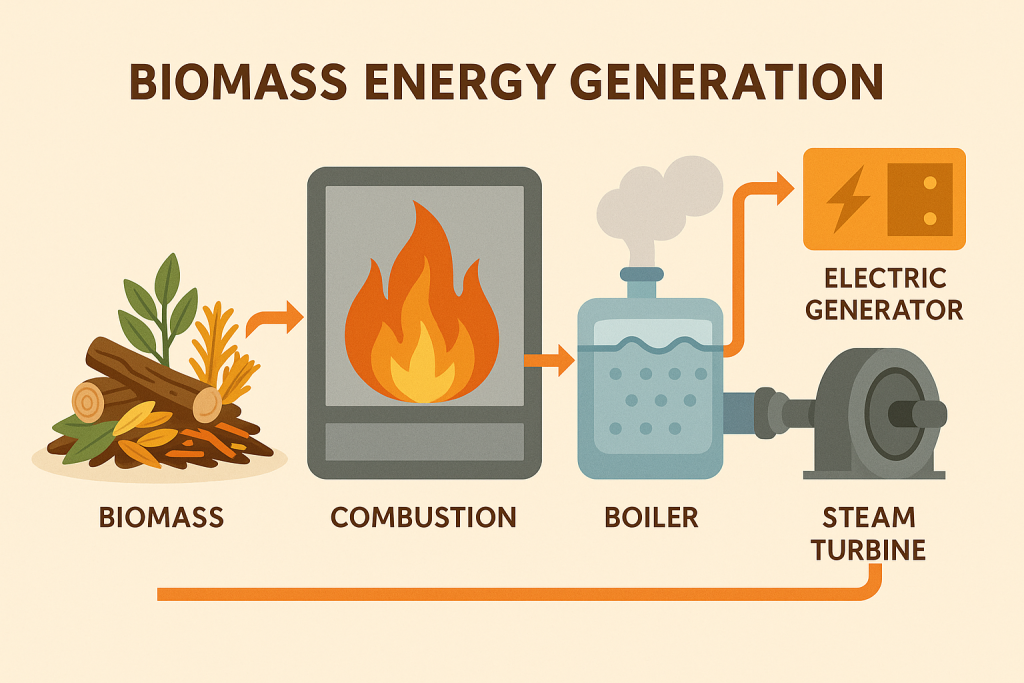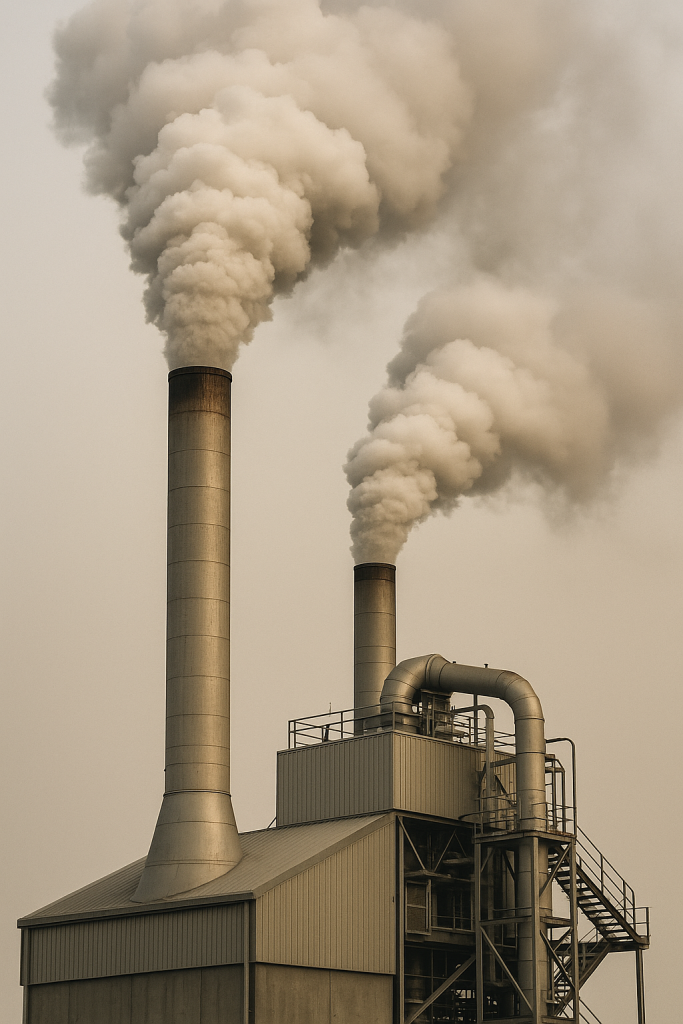Biomass energy is often grouped with solar and wind under the clean energy label, but the reality is far more complex.
While it’s true that biomass sources like wood, agricultural waste, and organic garbage can be renewed more quickly than fossil fuels, the environmental and health consequences of burning these materials are raising serious questions.
In fact, studies show that some biomass power plants can emit particulate pollution levels comparable to coal, challenging the idea that this energy source is truly clean.
This article explores the science and controversy behind biomass energy—what it is, how it works, and whether it lives up to its reputation as a clean and renewable resource.
Here’s what you’ll learn:
- What biomass energy is and the types of materials used to produce it
- The key benefits of biomass, including its renewable nature and role in waste reduction
- Environmental and public health concerns tied to biomass combustion
- The ongoing debate over carbon neutrality and biomass’s climate impact
- What determines whether biomass can truly be considered clean energy
By the end of this post, you’ll have a science-based understanding of the advantages and drawbacks of biomass energy—and the critical factors that influence whether it helps or harms efforts to build a cleaner, healthier future.
What Is Biomass Energy?
Biomass energy is produced by converting organic materials—such as plants, wood, agricultural residues, animal waste, and even garbage—into usable energy. This energy can take the form of electricity, heat, or transportation fuels. Because these materials come from living or recently living organisms, they are often considered renewable, provided they are replenished sustainably.

Common Biomass Sources
Biomass can come from a wide range of sources, including:
- Wood and wood pellets – harvested from forests or made from sawmill waste
- Crop residues – such as corn stalks, wheat straw, and rice husks
- Animal manure – used in anaerobic digesters to produce biogas
- Municipal solid waste – organic components of garbage that are burned in waste-to-energy plants
Energy Conversion Methods
There are several ways to convert biomass into energy:
- Combustion: Direct burning of biomass materials to produce steam, which drives turbines to generate electricity
- Gasification: Heating biomass in a low-oxygen environment to produce syngas, which can be used for power or fuel
- Anaerobic digestion: Breaking down organic material in the absence of oxygen to produce methane-rich biogas
- Pyrolysis: Decomposing biomass at high temperatures to produce bio-oil, gases, and char
Benefits of Biomass Energy
Despite the controversy, biomass energy does have several advantages that support its inclusion in renewable energy portfolios.
Renewable and Replenishable
One of the most cited benefits of biomass is that it’s renewable. Unlike fossil fuels, which take millions of years to form, biomass materials like crops and trees can be regrown within years or decades. When managed sustainably, this cycle of growth and harvest can provide a continuous supply of energy without depleting natural resources.
Carbon Neutral Potential
The idea of biomass being carbon neutral is based on the natural carbon cycle. Plants absorb carbon dioxide (CO₂) from the atmosphere as they grow. When biomass is burned, that CO₂ is released back into the air. In theory, if new plants are grown to replace those used for energy, the cycle balances out, resulting in no net addition of CO₂ to the atmosphere—assuming sustainable sourcing and regrowth.
Waste Management and Energy Reliability
Biomass energy also plays a role in waste reduction. By converting agricultural residues, animal manure, and organic municipal waste into energy, biomass helps divert materials from landfills and reduces methane emissions from decomposing waste. Additionally, unlike solar and wind, biomass energy is dispatchable—it can provide power continuously, regardless of weather or time of day.
Environmental and Health Concerns

While biomass has benefits, there are significant downsides that challenge its classification as clean energy.
Air Pollution and Health Risks
Burning biomass releases a range of pollutants including particulate matter (PM), nitrogen oxides (NOₓ), carbon monoxide (CO), volatile organic compounds (VOCs), and hazardous air pollutants like acrolein and methanol. These substances can cause or worsen respiratory diseases, trigger heart attacks, and contribute to premature death. In some cases, biomass plants emit more particulate pollution than coal-fired plants.
Disproportionate Community Impact
Biomass facilities are often located near low-income or minority communities. These communities face increased exposure to pollution, noise, and traffic from biomass operations, raising serious environmental justice concerns. The health burden is not evenly distributed, and vulnerable populations often bear the brunt of the impacts.
The Carbon Neutrality Debate
While the concept of carbon neutrality is central to the defense of biomass energy, it remains one of the most debated aspects.
Lifecycle Emissions
To truly assess biomass’s climate impact, it’s important to consider emissions across the entire lifecycle—harvesting, processing, transportation, and combustion. Each of these steps contributes to greenhouse gas emissions. If forests are cleared for biomass and not regrown quickly enough, the resulting carbon debt can take decades or even centuries to repay, undermining short-term climate goals.
Forest Management and Deforestation
Unsustainable practices such as clear-cutting forests for wood pellets can reduce biodiversity, diminish soil health, and eliminate carbon sinks. Forests play a vital role in absorbing CO₂, and their destruction can turn a theoretical carbon-neutral energy source into a net emitter of greenhouse gases.
Ecosystem and Biodiversity Impacts
Habitat Destruction
Industrial-scale biomass production often involves harvesting large areas of forest or converting land into monoculture plantations. These actions destroy habitats for wildlife and reduce ecosystem services like water filtration and climate regulation. Monocultures also make ecosystems more vulnerable to disease and pest outbreaks.
Soil and Water Impact
Removing biomass from the land reduces the organic matter that helps maintain soil structure and fertility. It can also increase erosion and runoff, polluting nearby water bodies with sediments and nutrients. Over time, this degrades the land’s productivity and ecological health.
Regulation, Compliance, and Policy
Violations and Oversight Gaps
Many biomass facilities have been cited for violating environmental standards. Inadequate pollution controls and regulatory oversight can lead to harmful emissions and unchecked environmental degradation. Enforcement of environmental laws is critical to ensuring biomass operations do not harm local communities and ecosystems.
Clean Energy Classification Debates
Biomass is often included in renewable energy policies and receives subsidies intended for clean energy. However, growing evidence of its environmental and health impacts has led to increasing criticism. Critics argue that calling biomass “clean” misleads the public and diverts funding from truly clean sources like wind and solar.
Future Solutions and Alternatives
Cleaner Combustion and Carbon Capture
Technological innovations may help reduce biomass’s environmental impact. Gasification produces fewer pollutants than traditional combustion, and Bioenergy with Carbon Capture and Storage (BECCS) has the potential to make biomass energy carbon-negative by capturing CO₂ before it enters the atmosphere.
Alternative Biomass Sources
Switching to less damaging sources like algae or waste gases could reduce the pressure on forests and minimize pollution. These sources don’t compete with food crops or require deforestation, making them more sustainable options if developed at scale.
Conclusion
So, is biomass clean energy? The answer depends on how it’s sourced, processed, and regulated. Biomass energy can be renewable and even carbon-neutral under the right conditions—but those conditions are not always met. Unsustainable harvesting, high air pollution, and negative health impacts challenge its status as clean energy.
Science shows that biomass is not inherently clean. Its environmental footprint varies widely depending on the practices used. As policymakers and communities work toward a cleaner energy future, it’s crucial to evaluate biomass with a critical eye, considering not just its renewability, but also its full lifecycle impact on climate, health, and ecosystems.
Clean energy policy must be rooted in evidence, not labels. Only with strict sustainability standards, pollution controls, and community protections can biomass play a responsible role in a low-carbon energy mix.
Final Thoughts: A Nuanced View of Biomass Energy
Biomass energy occupies a unique and complex space in the clean energy conversation. While it offers renewable potential and can contribute to waste reduction and energy reliability, its environmental and public health impacts cannot be overlooked. The reality is that biomass is not inherently clean—it becomes cleaner or dirtier depending on how it is sourced, processed, and regulated.
To truly consider biomass a part of a sustainable energy future, it must be held to rigorous environmental standards. This includes sustainable harvesting, pollution controls, lifecycle emissions assessments, and protection of vulnerable communities. Without these safeguards, the risks to air quality, ecosystems, and climate goals may outweigh the benefits.
As we transition to a low-carbon future, it’s essential to critically evaluate every energy source—not just by its label, but by its real-world impact. Biomass may have a role to play, but only under conditions that ensure it supports, rather than undermines, environmental and public health.
For more insights into how various energy sources stack up in terms of sustainability and climate impact, check out this in-depth resource on biomass and clean energy.

